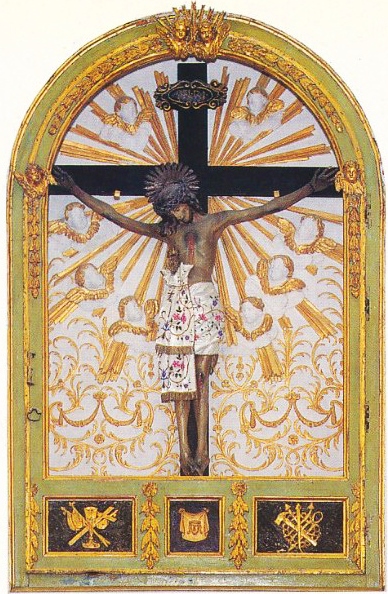Celebration program

Feast of the SS. crocifisso della pioggia
an ancient tradition in the Gianguarna district
The end of August

The origins of the Feast
The story unfolds in 1751 when a group from Burgio, carrying an image of the Crucifix crafted in Palermo, found themselves halted by a fierce storm in Cammarata, seeking refuge in the Church of the Annunziata. Remarkably, the storm abated once the Crucifix was brought into the sanctuary, prompting the group to continue their journey. However, their departure was short-lived as the skies darkened anew, unleashing a storm of even greater ferocity. This compelled them to return the Crucifix to the church, placing it upon the high altar. Subsequent efforts to remove the Crucifix proved futile, making it apparent that it was divinely intended to remain there.
The Benedictine nuns of the adjoining monastery rallied to gather the sum demanded by the Burgio group as compensation, ensuring the Crucifix’s stay. Miraculously, a young nun, previously barred from taking her vows due to blindness, was accepted and offered her dowry for the Crucifix’s purchase. This act led to the first miracle, restoring her sight.
Tradition also recounts another marvel concerning the unique posture of Christ on the Crucifix, with legs extended rather than the typical contracted depiction. Following a service of solemn gratitude, as the congregation and nuns queued to venerate the Crucifix, one particularly short nun's heartfelt prayers for the ability to kiss Christ’s feet were answered by the miraculous elongation of his legs, a pose in which he remains venerated to this day.


The church of the Annunziata
Nestled in the lower part of the town, in an area likely named Gianguarna, a term of Arab origin, stands the quaint Church of the Annunziata. Originally dedicated to Saint Mary of the Sick, this church has preserved its ancient architectural essence, particularly in its 16th-century pronaos. A grand pointed arch marks the entrance, elevating the church's facade. To the right, two additional pointed arches rest on columns topped with cushions, all adorned with symbolic sculptures. A square bell gable, a recent addition, complements the old structure. Adjacent to the church was the Benedictine monastery, erected in the 15th century by Count Abatellis. Despite succumbing to a landslide at the end of the 18th century, which demolished the monastery, the church miraculously remained unscathed.
The church's interior, consisting of a single nave, is adorned with exquisite eighteenth-century stuccoes in pure gold. On the inner facade wall, remnants of an ancient fresco, now barely discernible, possibly depict the Coronation of the Virgin. Among its treasured artifacts is a large canvas portraying the Penitent Magdalene, attributed to the school of Guido Reni, salvaged from the similarly named, now-ruined church. Another eighteenth-century canvas captures the Annunciation of the Virgin, alongside artistic wooden statues, including the Madonna Annunziata and Saint James the Apostle, originally housed in his namesake church. The most venerated relic for the people of Cammarata is the Crucifix, known as "della Pioggia," associated with a miraculous tale preserved by tradition and chronicled by Domenico Di Marco.




